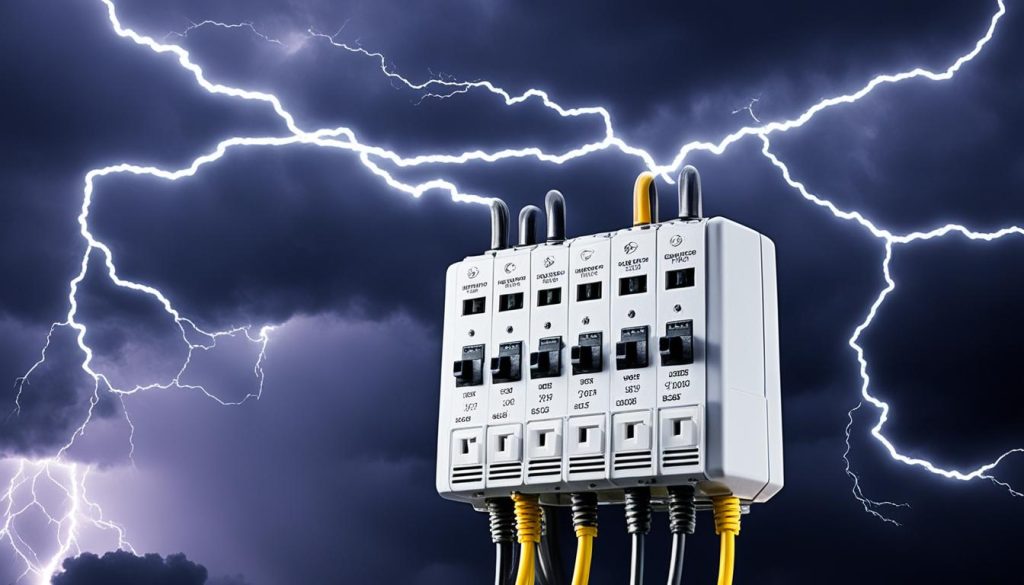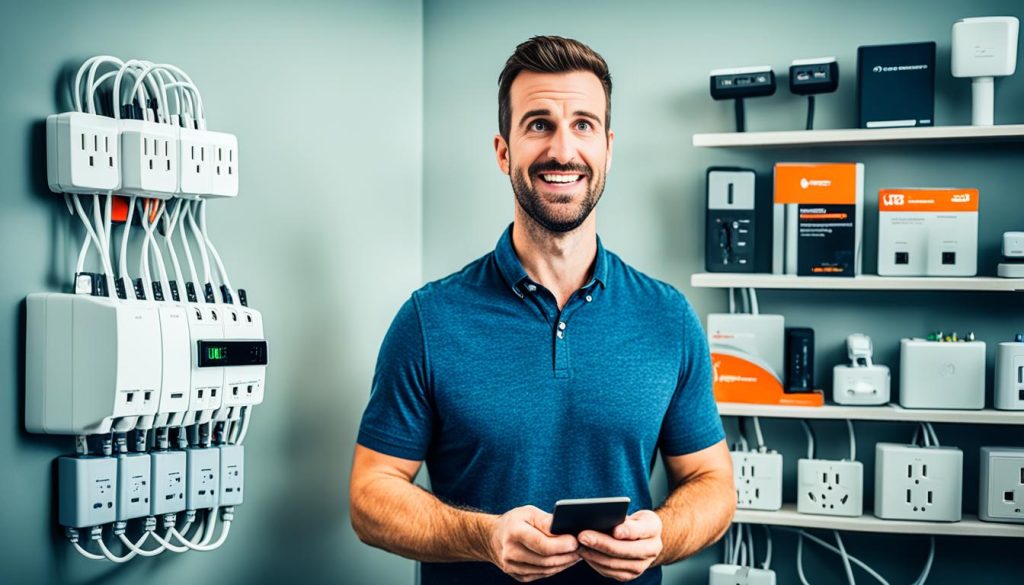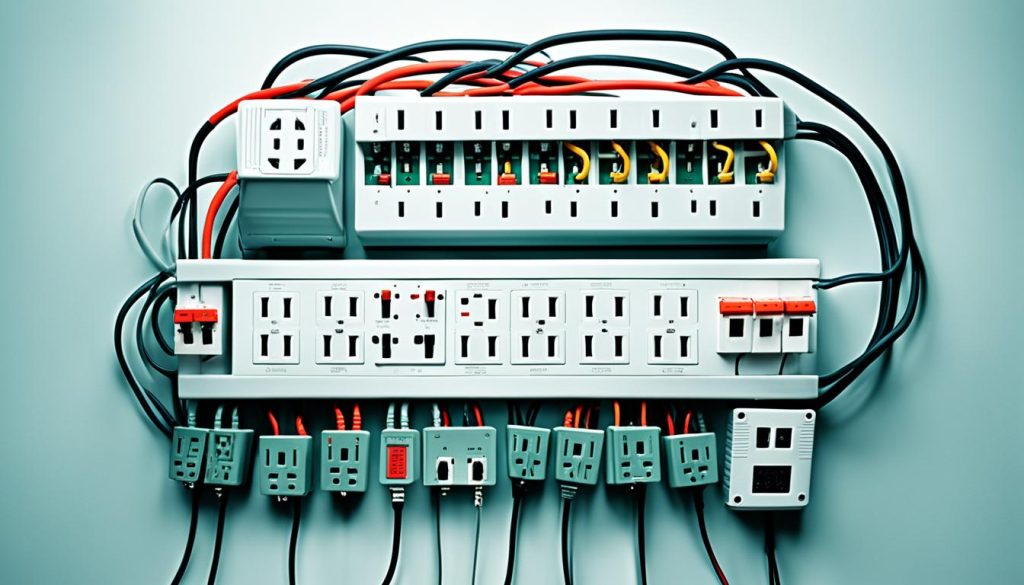When it comes to protecting your electronic devices and ensuring a reliable power supply, understanding the difference between a relocatable power tap and a surge protector is crucial. These two devices serve different purposes and provide distinct levels of protection, so it’s important to know which one is right for your needs.
A relocatable power tap, also known as an extension cord with multiple outlets, is a convenient solution for powering multiple devices from a single outlet. It typically features an on/off switch and provides extra outlets for your devices. However, it does not offer any protection against power surges.
In contrast, a surge protector is designed to safeguard your electronic equipment from power surges, which can occur due to lightning strikes or faults in the power supply. It contains an internal element that diverts excess current and prevents it from damaging your devices. Surge protectors are essential for sensitive electronics like computers, laptops, TVs, and gaming consoles.
Before purchasing a power strip or surge protector, it’s important to check for certain markings and features. Look for the words “TRANSIENT VOLTAGE SURGE SUPPRESSOR” on your power strip to ensure it offers surge protection. Surge protectors will also have a Joules rating, indicating the amount of energy they can absorb. Additionally, look for the label “UL 1449” or “surge protection device (SPD)” to ensure you’re getting a reliable surge protector.
Key Takeaways:
- A relocatable power tap is an extension cord with multiple outlets, while a surge protector safeguards against power surges.
- Check your power strip for surge protection markings and a Joules rating.
- Look for the label “UL 1449” or “surge protection device (SPD)” to ensure you’re buying a reliable surge protector.
- Power strips are useful for powering multiple devices, but they do not offer surge protection.
- Surge protectors are essential for sensitive electronics like computers, laptops, and TVs.
Understanding Power Strips and Surge Protectors
Power strips and surge protectors are essential devices for managing and protecting your electrical equipment. While they may appear similar, it’s important to understand the key differences between them to ensure the safety and longevity of your devices.
Power strips are devices that provide multiple electrical outlets, allowing you to connect and power multiple devices simultaneously from a single power source. They are widely used in homes, offices, and various settings where multiple devices need to be connected. Power strips can range from basic models with two to four outlets to advanced ones with a dozen or more outlets. They are typically equipped with an on/off switch and a power cord for flexibility in positioning.
However, it’s important to note that power strips do not provide any power surge protection. They act as a convenient way to expand the number of outlets available but do not safeguard against voltage spikes or power surges. This means that in the event of a power surge caused by lightning or electrical faults, your devices connected to a power strip may be vulnerable to damage.
Surge protectors on the other hand, are specifically designed to protect electronic equipment from power surges. They are often mistaken for power strips due to their similar appearance. However, surge protectors have an additional element that distinguishes them from power strips – they contain surge suppression technology.
A power surge is a sudden increase in electrical voltage that can cause significant damage to electronic devices. It can occur due to lightning strikes, power grid issues, or electrical malfunctions. Surge protectors are equipped with surge suppression circuits that detect and divert excess voltage away from your devices, redirecting it harmlessly to the ground. This helps protect your valuable electronics from damage and ensures their safe operation.
The key difference between power strips and surge protectors lies in their ability to provide power surge protection. While power strips merely extend the number of available outlets, surge protectors offer an added layer of defense against unpredictable power surges. It is recommended to use surge protectors for sensitive electronic devices such as computers, televisions, gaming consoles, and home entertainment systems.
“Surge protectors act as a first line of defense, shielding your devices from damaging power surges and ensuring their longevity.”
Power Strips vs. Surge Protectors: A Quick Comparison
| Feature | Power Strips | Surge Protectors |
|---|---|---|
| Number of outlets | Multiple | Multiple |
| On/Off switch | Yes | Yes |
| Power surge protection | No | Yes |
| Surge suppression technology | No | Yes |
| Recommended for sensitive electronics | No | Yes |
As shown in the table above, surge protectors offer the added benefit of power surge protection, making them the ideal choice for devices that require greater protection against potentially damaging voltage spikes.
Now that you have a clear understanding of power strips and surge protectors, you can make informed decisions to ensure the safety and longevity of your electronic devices. In the next section, we will discuss how to identify surge protectors and the important features to look for when purchasing one.
Identifying Surge Protectors
Surge protectors play a crucial role in safeguarding your electronic devices from power surges. To ensure you have the right protection, it’s important to be able to identify surge protectors accurately. Here are some key features and markings to look for:
Additional Outlets
Surge protectors often come equipped with additional outlets to accommodate various devices. These outlets can be specifically designed to protect phone lines, modems, ethernet cables, or coaxial cables. This added protection ensures comprehensive electrical safety for all your connected devices.
Joules Rating
A surge protector’s Joules rating indicates its capacity to absorb energy from power surges. Higher Joules ratings signify greater protection. When selecting a surge protector, look for one with a sufficient Joules rating to meet your power surge protection needs.
Labeling and Certifications
To ensure you are purchasing a surge protector rather than a regular power strip, carefully examine the labeling and certifications. Look for the label “UL 1449” or “surge protection device (SPD)” on the product packaging or body. These labels provide assurance that the device has undergone rigorous testing and meets industry standards for electrical safety.
Did You Know? Not all power strips are surge protectors. It’s essential to differentiate between the two to ensure proper electrical safety.
By identifying these features and markings, you can confidently select surge protectors that offer optimal electrical safety for your valuable electronic devices.

| Feature | Description |
|---|---|
| Additional Outlets | Surge protectors may have extra outlets to protect phone, modem, ethernet, or coaxial cables. |
| Joules Rating | The rating indicates the maximum amount of energy a surge protector can absorb. |
| Labeling and Certifications | Look for the label “UL 1449” or “surge protection device (SPD)” to ensure it is a surge protector. |
Different Types of Surge Protectors
When it comes to safeguarding your electronic devices from harmful power surges, there are various types of surge protectors available in the market. Understanding these different options will help you choose the right one that suits your specific needs.
1. Relocatable Power Taps: These surge protectors are portable and can be easily moved from one place to another. They provide a convenient and compact solution for powering multiple devices simultaneously. With a relocatable power tap, you can ensure that your devices stay protected even when you’re on the go.
2. Surge Protector Outlets: These surge protectors are designed to be installed directly into the walls of your home or office. With built-in surge protection, they offer a seamless and integrated solution for protecting your devices. Surge protector outlets provide a space-efficient and aesthetically pleasing option, as they eliminate the need for additional power strips or extension cords.
3. Type 1 Surge Protectors: Type 1 surge protectors are external devices typically installed at the base of lightning conductors. They are designed to safeguard entire buildings or structures against high voltage surges caused by lightning strikes. Type 1 surge protectors provide an advanced level of protection and are essential for areas prone to lightning activity.
4. Type 2 Surge Protectors: Type 2 surge protectors are typically installed inside your home as an addition to the breaker box or electrical panel. They offer comprehensive protection against power surges originating from the electrical grid. Type 2 surge protectors are an essential component of any residential electrical system, ensuring the safety and longevity of your valuable devices.
Choosing the Right Surge Protector
When selecting a surge protector, consider factors such as the level of protection required, the number of outlets needed, and the specific location where it will be used. Assess the types of devices you plan to connect and consider any specific requirements they may have. Consult with a qualified electrician if you are unsure about the appropriate surge protection for your specific setup.
Remember, investing in a suitable surge protector is a wise decision to protect your electronic equipment from unexpected power surges. Whether you need a portable power solution for your travels or a fixed installation for your home, finding the right surge protector will ensure uninterrupted power and peace of mind.
Considerations for Buying Power Strips or Surge Protectors
When it comes to purchasing a power strip or surge protector, there are several important factors to consider. These considerations can help ensure that you make the right choice and provide maximum protection for your devices. Here are some key points to keep in mind:
- UL Certification: Look for power strips and surge protectors that have UL certification. UL certification indicates that the products have met safety standards and have undergone rigorous testing to ensure their reliability and performance.
- Electrical Rating: It is crucial to check the electrical rating of the power strip or surge protector. The electrical rating determines the amount of power the device can handle safely. Make sure the device can support the power requirements of the devices you plan to connect.
- Suppressed Voltage Rating: Surge protectors are designed to safeguard your devices against power surges. The suppressed voltage rating is a critical specification to consider. A lower suppressed voltage rating indicates better protection against power surges. Look for surge protectors with a lower rating for optimal protection.
- Limitations of Power Strips: While power strips are convenient for expanding the number of outlets, it’s important to know their limitations. Power strips do not provide the same level of surge protection as dedicated surge protectors. Avoid overloading power strips, especially with high-power devices like heating products and appliances that can draw a significant amount of power.
- Considering Home Outlets: If you find yourself relying heavily on power strips, it may be an indication that your home needs additional outlets. Consider consulting with an electrician to evaluate your electrical needs and potentially add more outlets in strategic locations.
By carefully considering these factors, you can make an informed decision when purchasing a power strip or surge protector. Remember, investing in the right device is crucial for protecting your valuable electronics from power surges and ensuring their longevity.

Safety Precautions for Power Strips and Surge Protectors
Safety is paramount when it comes to using power strips and surge protectors to protect your electronic devices. By following a few important precautions, you can ensure the electrical safety of your home and minimize the risk of fire hazards.
One important tip is to never throw a rug over the cord of a power strip. This can cause the wires to break and potentially create a fire hazard. It’s essential to keep the cords of power strips and surge protectors free from obstructions to prevent overheating and potential electrical fires.
Regularly inspect the cords and strips for any signs of damage. Frayed or exposed wires can be dangerous and pose electrical risks. If you notice any damage, it’s crucial to replace the power strip or surge protector immediately to avoid further safety hazards.
Remember, power strips and surge protectors do not have an expiration date. However, it’s important to monitor their condition regularly to ensure they are functioning properly. If you notice any issues or signs of wear and tear, replace them promptly to maintain the electrical safety of your devices.
By following these safety precautions, you can protect your home, belongings, and loved ones from potential electrical hazards and fire risks. Electrical safety should always be a priority when using power strips and surge protectors.
| Safety Precautions | Importance |
|---|---|
| Do not throw a rug over the cord | Prevents wire breakage and fire hazards |
| Regularly inspect cords and strips | Detect and replace damaged components |
| Replace damaged strips or protectors | Maintain electrical safety |

Choosing the Right Protection for Your Devices
When it comes to protecting your valuable electronic devices, ensuring their safety is of utmost importance. While basic power strips may suffice for devices like lamps or phone chargers, sensitive electronics like computers, laptops, and TVs require extra precaution. This is where surge protectors come into play, providing the necessary defense against power surges that can potentially cause significant damage.
Investing in a quality surge protector is a wise decision to safeguard your electronic equipment from unexpected voltage spikes. Without proper protection, power surges can fry circuit boards, damage internal components, and ultimately render your devices unusable. By using a surge protector, you can have peace of mind knowing your devices are shielded from electrical hazards.
Electrical safety should always be a top priority, especially when dealing with expensive and essential electronics. To ensure the longevity of your devices, consider using surge protectors that offer features like multiple outlets, USB ports, and built-in circuit breakers. These added functionalities not only provide power surge protection but also enhance convenience and utility in managing various devices simultaneously.
FAQ
What is the difference between a relocatable power tap and a surge protector?
A relocatable power tap is essentially an extension cord with multiple outlets and an on/off switch, while a surge protector has an element inside that protects against power surges.
How do power strips and surge protectors differ?
Power strips are devices that contain multiple electrical sockets, allowing you to power multiple devices from a single outlet. Surge protectors, on the other hand, have an additional element that protects electronic equipment from damage caused by power surges.
How can I identify a surge protector?
Surge protectors can often be identified by certain features and markings. Look for additional outlets for protecting phone, modem, ethernet, or coaxial cables. They will also have a Joules rating, indicating the maximum amount of energy they can absorb. Look for the label “UL 1449” or “surge protection device (SPD)” to ensure it is a surge protector.
What are the different types of surge protectors?
There are different types of surge protectors, including relocatable power taps that are portable and can be moved from place to place, and surge protector outlets that are installed in walls. There are also Type 1 and Type 2 surge protectors designed to protect entire buildings against voltage spikes.
What should I consider when buying a power strip or surge protector?
When buying a power strip or surge protector, look for UL certification to ensure safety standards have been met. Check the electrical rating to ensure it can handle the power you will be drawing from it. Look for a suppressed voltage rating on surge protectors, as a lower rating indicates better protection against power surges.
What safety precautions should I follow when using power strips and surge protectors?
Never throw a rug over the cord of a power strip, as it can cause the wires to break and potentially create a fire hazard. Regularly inspect the cords and strips for damage, and if any damage is found, replace them. While power strips and surge protectors don’t necessarily expire or need to be replaced, it’s important to monitor their condition and replace them if necessary.
How do I choose the right protection for my devices?
For devices that are less susceptible to power surges, basic power strips may be suitable. However, for computers, laptops, TVs, and other sensitive electronics, using a surge protector is highly recommended. Surge protectors provide the necessary protection against power surges that can cause significant damage to these devices.


